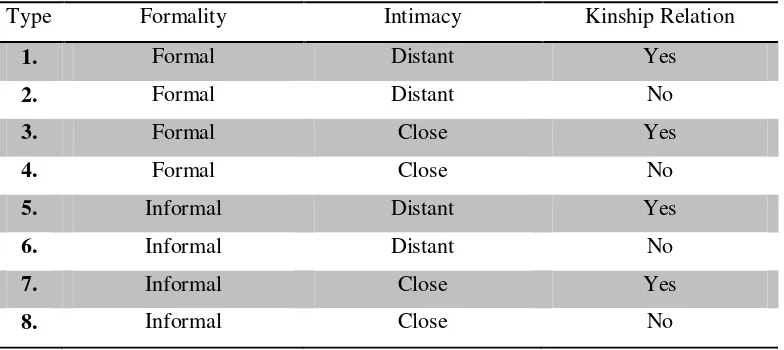26 Hanifa Muslima, 2014
The Realizations Of Self-Reference Among Young Adults In Indonesia Universitas Pendidikan Indonesia | repository.upi.edu | perpustakaan.upi.edu
CHAPTER III
RESEARCH METODHOLOGY
This chapter presents the methodology used in the study. As mentioned in Chapter
I, this study seeks to examine the realizations of self-reference in different
contexts and or situations including formality, intimacy, and kinship relations and
whether or not gender influences the realization of self-reference, also the
underlying reasons. The rest of this chapter presents the design, procedures of data
collections and procedures of data analysis.
3.1 Research Design
This research applied a descriptive study containing mostly qualitative description
supported by some descriptive quantification. The studywasappliedto describe
how young adults realize self-reference in different contexts or situations and to
find out whether or not gender influences the use of self-reference, also the
reasons.
3.2 Procedures of Data Collections
This part consists of subjects of the research, questionnaire, and interview. Further
descriptions can be seen in the following sections.
3.2.1 Subjects of the research
adequate size to produce reliable results. That is to determine the number
of respondents as well as the variation of age, gender, and social class
giving effect to the language used. Third, the sample must be designed in
27 Hanifa Muslima, 2014
The Realizations Of Self-Reference Among Young Adults In Indonesia Universitas Pendidikan Indonesia | repository.upi.edu | perpustakaan.upi.edu
There were 27 English students who participated in this research by
answering the questionnaire. However, this research only chose 12 students who
qualified some criteria including age, gender, and ethnic. They were six males and
six females, originated from West Java (Sundanese), whose age ranges between
21 and 23 year old. By choosing only 12 respondents, the data analysis would be
simpler, more convenient, and more focused.
3.2 Procedures of Data Analysis
This part consists of questionnaire and interview. Further descriptions can be seen
in the following sections.
This research employed questionnaires in the form of Discourse
Completion Task (DCT) to find out what they would say in that situation
regarding the use of self-referring terms. DCT is used to “elicit data in responding
to problematic, contextually specific prompts especially the studies of
metaphorical conceptualizations” (Parvaresh&Tavakoli, 2009, p. 366).
Furthermore, the questionnaire consists of the respondents’ identity
includes name, contact number, age, and gender (this information is confidential).
Besides the identity, there are 16 items which explore the combinations of social
variables including formality, intimacy, and kinship relations. There are eight
types of contexts resulting from the combination of the three aspects, as shown in
28 Hanifa Muslima, 2014
The Realizations Of Self-Reference Among Young Adults In Indonesia Universitas Pendidikan Indonesia | repository.upi.edu | perpustakaan.upi.edu
Table 3.1 Types of Context Combinations
Type Formality Intimacy Kinship Relation
1. Formal Distant Yes
The context combinations above are formulated into 16 situations (2 items
for each situation). The respondents were asked to answer the questions in given
situation of conversations written in Indonesian. The conversations used in the
questionnaire are mostly between a speaker and an interlocutor rather in a group
conversation. The model of questionnaire is shown as follows.
Ayahmubarusajapulangdariluarkota.
<Eng> Your dad has just arrived from downtown. He called and asked you
to pick him in rail station; unfortunately you are busy and cannot make it.
How would you say (to him)?
Answer:
Ba (dad), Enip (I, personal name) cannot pick you up. I got thesis
29 Hanifa Muslima, 2014
The Realizations Of Self-Reference Among Young Adults In Indonesia Universitas Pendidikan Indonesia | repository.upi.edu | perpustakaan.upi.edu
3.2.2 Interview
Interviews are particularly useful for getting the story behind a respondent’s
experiences. The interviewer can get in-depth information around the topic.
Interviews may be useful as confirmation to certain respondents to questionnaires,
e.g., to further confirm and investigate their responses (McNamara, 1999in
Valenzuela &Shrivastava, 2002).
In this research, interviews were conducted to identify respondents’ claim
about the use of certain self-referring term and also the reasons. The interviews
were held directly on September, 23rd 2014 and via phone on September, 24th
2014. The interview data can be seen in Appendix.
3.3Data Analysis
The data were analyzed in the following steps. First, self-referring terms were
identified from each utterance. Second, self-referring terms are classified. Third,
the data were quantified by determining the percentage for each classification of
the terms. Fourth, the data were observed to see trend of the data in the contexts.
Fifth, the identification of respondents’ claim concerning certain self-referring terms (i.e. whether or not they use certain self-referring terms) by conducting
interviews. This information was used to confirm the terms that they used in DCT
questionnaire. They were also asked about the reasons. Sixth, the data were
analyzed to investigate the realizations of self-reference across contexts and the
influence of gender on the use of self-reference. The last was drawing conclusion
from the whole analysis of the research.
In order to determine the percentage of each self-reference classification,
the researcher needed to compute numerical data by using a simple scaling
composed by Thorsten (1992 in Salma, 2013).
P = �� %
� Note:
30 Hanifa Muslima, 2014
